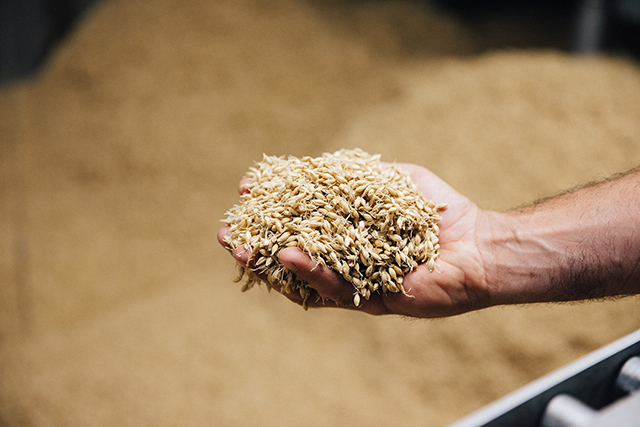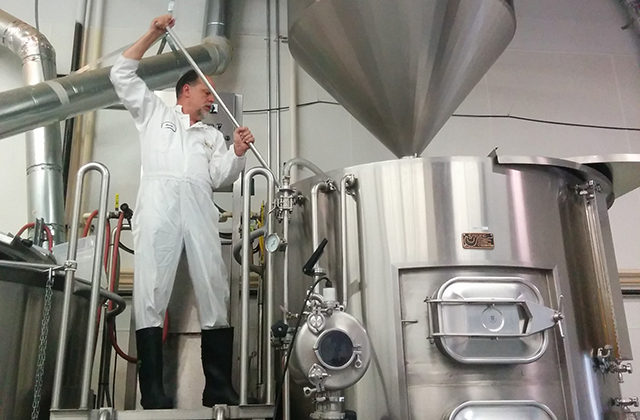
Proper planning is always a key element for future success by many breweries that have seen growth. Being able to save on malt handling can be paramount in that success.
One of the things that has helped AleSmith in growth is to more accurately forecast their production needs, said Head Brewer and Director of Brewery Operations, Ryan Crisp.
“This has allowed us to take advantage of bulk shipments and pricing for specialty malts, especially those that are shipped internationally,” he said. “It also allows us to contract our malt needs further out and lock in the best rates with our suppliers.”
Jason Perkins of Allagash Brewing said that the Maine brewery has certainly done a number of things over the years as they grew with buying in bulk. Purchasing a silo was one major aspect.
“For a brewery our size and even substantially smaller breweries, the payback on a bulk silo was pretty quick,” he said. “Even for not a ton of usage you can pay for it relatively quickly. Ordering in bulk is helpful.”
There are some malt companies that can lease a silo so a smaller brewery doesn’t pay anything different for grain for a certain period of time until the silo that they put in is paid off. Perkins suggested to look to see if coming up with a loan or cash is harder to do than leasing, which could also be a great option as well.
Allagash also uses super sacks quite a bit. Their second-most used grain by the Maine brewery is all in super sacks and is soon to move into a silo.
Crisp added that AleSmith tries to use super sacks and their silos when possible to get the best per pound rate as well.
Chicago’s Revolution has four outdoor silos and storage space at the brewery, which allows them to take bulk shipments of grain via a pneumatic truck delivery and take full truck deliveries of bag malt and super sacks from domestic and European malt companies.
“Large bulk is going to get a drop in price per pound, which adds up pretty quickly over a year,” Perkins said of super sacks. “Also, you have less recycling of bags, less handling, with less wear and tear on employees.”
Allagash also focuses quite a bit on their brewhouse efficiencies.
“Certainly quality comes first, but we also know every bit of efficiency that we can gain in brewhouse is going to save us costs on grains,” Perkins said.
Perkins did note that it’s “pretty simple math” to track such savings as well, but he admits they don’t talk about savings in dollars and cents as much as tracking efficiency.
“Occasionally when I’m putting together a presentation for our staff meeting or something, then I’ll think about crunching numbers,” he said. “But we tend to just talk about it in efficiency overall as a percentage number, not as not as a dollar number. But it’s a very easy to with a very simple calculation to convert that into a dollar value.”
Saint Arnold’s Brewing Operations Manager, Aaron Inkrott, said that the Houston brewery has worked a lot on brewhouse optimization, and not only in malt, but hops, water usage, and time and labor. They build out a production schedule four to six weeks out, so Inkrott said it’s important to have all the materials on hand in case the brewery is seeing growth in a particular brand.
“[Our] focus is to increase brewing efficiency, without affecting the brand,” he said.
Being able to dial in high efficiency without changing sensory is the sign of a brewery that has been able to save on cash in the long run.
“If it affects overall flavor, then don’t do it,” Inkrott said. “But if there’s no difference, proved through sensory, then why wouldn’t you?”
Revolution has looked to stretch their malt budget by establishing contracts with their various suppliers and locking in pricing based on projections for the coming year’s brewing.
“It is very helpful for the farmers, malting facilities and suppliers to have a close approximation of what your upcoming needs are going to be,” said Head Brewer at Revolution, Jim Cibak.
Revolution also has upgraded its milling operation to a GEA Millstar (Wet Mill), which has increased efficiency, reducing the amount of malt they require per batch to achieve the same finishing yield of beer.
“We also strive to be as efficient as possible and maximize extraction with our brewhouse operations,” Cibak said.
Revolution’s major change in recipe formulation has been the overall reduction in malt usage per brew, which brings their cost per barrel down and profitability up.
“This allows us to reduce our price per pound and shipping costs significantly,” Cibak said.
Perkins suggested to talk to suppliers on being able to lower your price per pound. There can be many options.
“Each supplier and what they’re willing to cut you for a bulk delivery deal is different from supplier to supplier,” he said. “It’s also dependent highly on where you’re getting it from. If you’re getting it from a malthouse that’s two hours away, it’s a lot different than a malthouse that’s halfway across the country.”
Crisp would advise smaller, growing breweries to carefully consider their long-term goals when selecting malt-handling equipment.
“Being able to silo multiple malts, accommodate super bags, and store container shipments will help drive malt cost down,” he pointed out. “It’s much easier to put the infrastructure in place up front than to modify an existing system later.
“Selecting a high-quality base malt with a high amount of extract will also help reduce the amount of malt needed over the course of the year. These small reductions in usage and price will add up to significant savings over time.”
Cibak would recommend a move toward acquiring a silo for base malts.
“It’s also a great idea to establish close relationships with your malt suppliers and be as honest as possible when it comes to your needs and projections,” he added. “Establishing malt contracts to lock in the best prices is key.”
He adds to invest in a good mill, and monitor your grist with a sieve analysis to ensure that you are getting the optimal grind on your malts. Dial in your brewhouse operations — especially your mashing and lautering programs — to make sure you are being as efficient as possible. “Monitoring first, last and ‘Kettle Full’ wort gravities and calculating your brewhouse efficiency is key for dialing in your mill settings and mash and lauter programs to maximize extraction from your malt,” Cibak said.
He also noted to keep an eye on your total cost per barrel.
“This is a key number I like to watch, which tells you how efficient you are from the start of your process to having bright beer ready to package in your tax determination tanks,” he said. “The finishing volume of beer ready to package will drive your cost per barrel up or down, so efficiency all through the brewing process is key to maximizing your profitability.”
Accounting software is a helpful tool for crunching numbers and keeping an eye on both your costs and inventory quantities in house and on contract.
Another malt-budget stretching activity that Revolution does is that when they brew a high-gravity beer to age in barrels, Cibak will recapture the last runnings of the wort in a smaller brew kettle to create a second-runnings beer.
“[They] are extremely profitable, especially when sold in your taproom for maximum profitability,” he noted.




Be the first to comment